Lord of the Rings

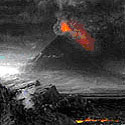
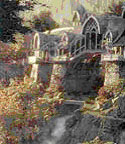
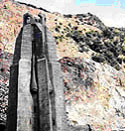
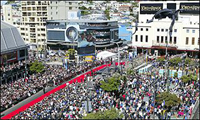
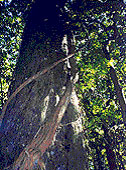
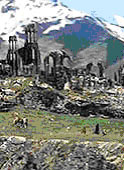

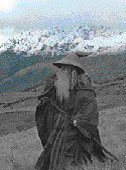
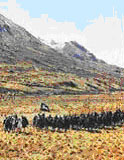

Following are the various regions throughout New Zealand that have been used to film the first, second and some of the third movies in The Lord of the Rings trilogy.
NORTH ISLAND
Waikato
The rolling farmlands of Hinuera in the Waikato were used to shoot exteriors for Hobbiton and the Shire in late 1999 and early 2000. A piece of farmland near the small town of Matamata in the heart of the Waikato was selected to be the home of Hobbiton. Crews began building the set in April 1998, then allowed it to weather for a year before filming began.
The Shire - Hinuera, Waikato
Taupo
Scenes involving the dark lord Sauron's domain of Mordor is represented in the films by the rocky plateau of Tongariro National Park. Though the famous volcano Ruapehu is not to be seen, out of respect for the wishes of the native Maori people to whom it is a sacred place, one of the other two volcanoes on the plateau now stand in for Mount Doom. Otherwordly formations, sulpheric pools and hot springs add to the strangeness of the region. With the help of a little special effects magic, Tongariro has become Mordor.
Mordor - Tongariro National Park
Kapiti Coast
Countryside near Otaki became the "East Road" from "Hobbiton", and the last homely house of the Elves 'Rivendell'.
Upper Hutt
Rivendell, the house of Elrond and home of Arwen, hosted the council over what should be done with the Ring. While much of Rivendell was computer generated and studio based, scenes involving Isengard and the Great River Anduin were filmed in Kaitoke and Hutt River, just a few minutes north of Upper Hutt and New Zealand's capital, Wellington.
Rivendell - Upper Hutt
Lower Hutt
Scenes involving the fortress of Minas Tirith, Isengard, Minas Morgul and Helms Deep were shot on location in Lower Hutt - a suburb located just north of Wellington. A quarry on Hayward's Hill was used as the setting for Helms Deep - the scene of The Two Towers climatic battle. This fortification was of the largest and most detailed sets from Lord of the Rings. The stunning set includes details right down to paving stones and statues. Filming of the Helms Deep scenes of The Two Towers took place at night over several weeks in an arduous schedule that exhausted actors and crew.
Helms Deep - Lower Hutt
Wellington
The Capital was used as a base of operations for the Lord of the Rings movies production. Here Peter Jackson and the cast and crew recorded the studio scenes, including Fangorn Forest and Helm's Deep interiors featured in The Two Towers and performed all the post production work. Various location scenes were filmed on the outskirts of the city. For example, Lower and Upper Hutt (located in the northern suburbs of Wellington), were used as the setting for Helm's Deep and Rivendell. Wellington premiered the Australasian premiers of both Lord of the Rings: Fellowship of the Ring and The Two Towers at the restored Embassy Theatre.
The historic Embassy, located in Wellington's Courtney Place district of trendy restaurants and cafés, was the center of a huge street party at both premiers. An estimated 10-15,000 revelers turned out for the December 18th premier of The Two Towers - some traveler from as far away as the UK and USA. Red carpet guests in attendance at both premiers were Elijah Wood (Frodo) and Hobbit friends, Billy Boyd (Pippin), Dominic Monaghan (Merry). However, the biggest cheer was reserved for local town hero, and Lord of the Rings Director, Peter Jackson. Jackson used The Two Towers premier to extract a public commitment from New Line Cinema to hold the world wide premier of the final installment of Lord of the Rings, The Return of the King, in Wellington. This was an amazing event, with a lengthy red carpet through the heart of the city to allow the stars to be seen and enable them to interact with the thousands of fans crowding the streets. Jackson, who started his career as the local film maker of quirky and very low budget horror movies, managed what many said was not possible; to bring not only the filming but full post production of a major Hollywood film to New Zealand. Jackson teamed with long time friend, Richard Taylor, to create Weta Studios. Weta, based in Wellington, manufactured all the costumes and props in the films, and also undertook almost all of the post production work on the films, including some of the most ambitious special effects ever attempted. Weta's creations form the centerpiece of the Lord of the Rings Exhibition - a major museum display of the film's magic that opened on December 19th at New Zealand National Museum in Wellington.
SOUTH ISLAND
Nelson
Nelson locations that feature in the Lord of the Rings film are Mount Owen (Dimril Dale hillside) and Mount Olympus (Eregion Hills and the Rough Country South of Rivendel). Both locations are in the interior of the Kahurangi National Park, one of three National Parks located in the Nelson region. Many props for the film were created by Nelson's innovative artists. These include jewellery, pottery, steelwork, carvings, garment dying, glassworks and costumes. Even the beer was brewed in Nelson.
Dimrill Dale - Nelson
Takaka
Takaka Hill served as the location for Chetwood Forest. Chetwood Forest, featured in the first Lord of the Rings, The Fellowship of the Rings, was the initial route of the Hobbits and Strider (Aragorn) on their hasty escape from Bree and the arrival of the Black Riders. The area lies on the border of Kahurangi National Park - the filming location for Dimril Dale and Eregion Hills and the Rough Country South of Rivendel.
Chetwood Forest - Takaka
Canterbury
Nestled deep on a Canterbury high country station was the set for Edoras, the fortress city of the Rohan people in the The Lord of the Rings: The Two Towers. One of the more elaborate sets, Edoras took eleven months to complete. Edoras is the capital of Rohan and is made up of a number of buildings encircling a central hill which is home to the Kings Hall, Meduseld. The finished product looks otherworldly and strangely historic, a testament to the truly remarkable atmosphere of the area and the skill of the set makers. The amazing location near Mount Potts, in the Rangitata river valley in the Ashburton district (around 2.5 hours drive inland from Christchurch) seemed purpose built for the production; a sheer-sided hill in the middle of an expansive plain, bordered by impassable mountains of rock and ice.
Director Peter Jackson and his team actually worked from inside the buildings that were constructed for the Mount Potts set - the interior scenes from Edoras were filmed several months beforehand in Wellington, so the large buildings in reality served as shelter and extravagant food tents for the approximately 300 cast and crew. When not sheltering from the elements at Mount Potts, many of the cast used the central location as a base to explore the rest of the magnificent South Island. Sir Ian McKellen was particularly taken with a magnificent journey to ArthurŐs Pass with Viggo Mortensen.
Viggo Mortensen (Aragorn)
'The location for Edoras was, to me, one of the most beautiful, the most impressive. Everything was constructed on this knoll, and reading the book, it's exactly what you would dream and hope Edoras would look like, and feel like.'
Ian McKellen
'Everyday we went there, spirits rose, whether it had snowed overnight, or the sun was out or it was pelting rain. There was majesty to that location. A secret valley, it seemed. A place where, if it had not been for the film, one would never have visited. That was a really magical time.'
Edoras - Canterbury
Queenstown
The adventure capital of New Zealand was an ideal setting for its majestic beauty. Queenstown's Lake Wakatipu was used as the location for 'Lothlorien'. Lothlorien, home to the Lady of the Forest, Galadriel. 'There lie the woods of Lothlorien!' said Legolas. 'That is the fairest of all the dwellings of my people. There are no trees like the trees of that land. For in the autumn their leaves fall not, but turn to gold.' Lord of the Rings, J R R Tolkien. The Southern Lakes of New Zealand - are renowned not only for their dramatic mountain scenery but for the autumn colours of introduced oak, chestnuts and poplars that line the roads and paths near the mountain towns of Queenstown and Arrowtown. Arrowtown, lies near another Lord of the Rings film location, the dramatic Skippers Canyon, site of filming for Liv Tylers most dramatic moment, her confrontation of the Black Riders at the Ford of Bruinen.
Tarras and Wanaka
'The Lord of the Rings' literally dropped out of the skies into Tarras. Searching for open plains with dotted trees and some forest, no fences, no houses and unlimited and uninterrupted views from flat land to snow-topped mountains, they descended in helicopters onto the banks of the Clutha River just outside Tarras township. Here, their crews filmed many of the sequences featuring the Black Riders as they searched for Frodo, pursuing him across the golden plains, and of the Orc attacks on the Fellowship. In all, crews were there for a month, filming many of the most immediately recognisable scenes of 'The Fellowship of the Ring' - and possibly, as we shall see later when released, other parts of the epic trilogy 'The Lord of the Rings'.
Tarras - Wanaka
Twizel
Twizel lies just down the road from Mt Cook/Aortaki National Park - where the spectacular opening scences of The Two Towers was filmed. At Twizel - a mountain town set in the Mc Kenzie Basin, extensive scenes set in Rohan were filmed for The Two Towers, as well as the battle of Pelennor Fields (featured in the third film, Return of the King). Ben Ohau Station, near Twizel provided the plains of Rohan (where Aragorn, Legolas and Gimli pursue the Orcs at the start of The Two Towers) and Rohan villages (destroyed by Saruman's armies in The Two Towers) were filmed. Eastemnet Gullies, (filmed for the third movie, The Return of the King) was also based here.
Pelenor Fields - Twizel
Glenorchy / Milford Sound
Areas near Milford Sound in the Fiordland National Park provided many scenic shots, including Mavora Lake 'Amon Hen', the river 'Nen Hithoel' and 'Fangorn Forest', located in near-by Glenorchy. The magnificent Elven wood 'Lothlorien' is none other than the area in the Dart Valley aptly named 'Paradise'. The setting for Isengard, with the help of Weta Studios computer wizadry, is the Dart River, with the spectacular Mount Earnslaw in the background.
Te Anau
The Dead Marshes were filmed at Kepler Mire in the Te Anau region. The Dead Marshes are featured in the second Lord of the Rings Movie - The Two Towers. The marshes provide a major barrier to Frodo and Sam's quest to reach Mordor. But with Gollum's help, the two start out across the marshes - the site of a major battle (and burial ground) of old. Te Anau, a small town, nestled on the edge of the massive Fiordland National Park was the base for filming in a number of The Two Towers locations including the Dean Marshes and Fangorn Forest. Given the extremely high rainfall in the region (over 400 inches a year in some parts of the park), both wetlands and dense moss-covered rainforest are features of the area.
The Southern Alps
The Southern Alps of the Central and Southern South Island was used extensively for location shooting in the Lord of the Rings. In particular, the dramatic peaks, beautiful glacier carved lakes and rivers and the Southern Alps mountain range doubled as the mighty Misty Mountains of J R R Tolkein's Middle Earth. For example, Mt Cook/Aoraki National Park forms the striking backdrop for the start of the The Two Towers - the Lord of the Rings. New Zealand's spectacular Southern Alps double as the great Misty Mountains - in and on which Gandalf battles the fiery evil of the Balrog.
